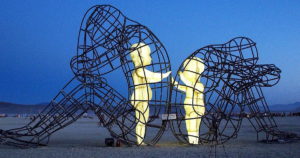
Inner Child

Several years ago, at the Burning Man festival, a sculpture was erected of two distressed adults; both seated with their backs to one another, heads in their hands. The figures were fashioned with a wire-like material, thus, making them transparent.
On the interior of both adult representations was a small illuminated child. While the adults faced away from one another, the inner children faced towards each other, their arms extended out, reaching for embrace.
This is one of my all-time favorite works of art, and like all art, it’s open to interpretation. Each admirer with a different take, and their own personal connection and symbolism to the piece.
To me, the sculpture conveys the idea that often, as adults we carry baggage, the responsibilities of adulthood in conjunction with our own meandering experience often leaves us damaged, and jaded. Particularly in regards, (but not limited to) romantic relationships.
We often tend to shut down instead of saying the words that need to be said. Both partners grow distant and stubborn, silenced by their pride, yet their inner children yearn to be loved, they yearn for freedom from the self-inflicted prisons imposed by their older selves…they yearn to play.
When it comes to conflict, often at times children work towards resolution in a much more functional and sensible way then their older counterparts. While adults tend to revel in resentment, children do not. Adults often cut ties and sever relationships in fear of becoming noticeably vulnerable, or in order to protect their own ego. At times, the argument resurrects from something senseless, and ultimately deemed as irrelevant once the damage is done.
Children haven’t yet been tainted by the world, they act on instinct. They do what feels right, they don’t consider similar situations that have happened in the past, or fear situations that may, or may not happen in the future. They truly live in the moment.
When it comes to children, arguments aren’t amplified by personal insecurities and irrational fears. Arguments are just arguments, and they’re often just as ridiculous as the adult versions of these. However, instead of bottling their feelings inside, and shutting the other person out, they verbalize their pain. They apologize to one another, share a fruit snack, and move on with their fucking day. In my opinion, a much more constructive and effective tactic.
As adults, we envy their sense of innocence, and value their honesty. They experience the world in a much more beautiful way then we do. As much as we admire their tactics we don’t endorse them on a personal or in an applicable manor. However, even (or especially) as adults, many of us tend to be attracted to those who bring out our inner child; to those who promote a sense of fun in otherwise dull situations. Those who remind us of the enjoyment and nostalgia of childhood, those who “play” with us.
This attributes greatly to the importance of play in the BDSM realm. Although in adult play there is a sexual undertone, the concept is the same. It is a healthy outlet for many adults, and it is an opportunity to allow our inner children to play. In those moments of escapism, we are free of responsibilities and judgment, we are free to let go of resentment and anger in an alternative way. We are no longer adults weighed down the world, but rather spirits free to explore it.
At times the play takes on a certain scenario or role (otherwise known as roleplay). It’s actually quite common to play out scenes from childhood, coined traditionally by therapists as reenactment. At other times, it’s less regimented with an understanding of likes and limits and both parties are free within that scenario. No matter how you prefer to play, in BDSM or any other area that it could be implemented, the point is, to play! Let that inner child free and you’ll be astounded by the benefits reaped by your adult self.








 Snapchat: misskaylala8
Snapchat: misskaylala8 OnlyFans:
OnlyFans: 
 Wishtender:
Wishtender:  Reddit:
Reddit: